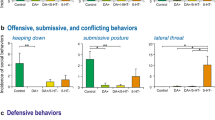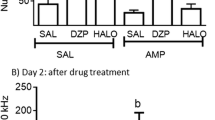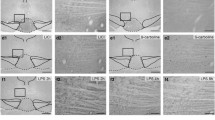Abstract
The effects of an “aggression”-reducing drug, fluprazine, and an “aggression”-enhancing drug, ethanol, were evaluated in mice using the target biting and resident-intruder paradigms. Under baseline conditions there was a high target biting rate immediately after the delivery of a 2.0 mA tail shock, an intermediate target biting rate during a 2-min intershock interval, and a low target biting rate during at 15-s tone stimulus which signaled the shock. During the 10-min resident intruder test sessions, resident males attacked bulbectomized intruders an average of 11.3 times with an average latency to the first attack of 68.3 s. Fluprazine caused a dose-dependent decrease in postshock and intershock interval target biting behavior, increased the latency to the first attack, and decreased the number of attacks in the intruder-evoked aggression paradigm. Ethanol exerted a biphasic effect in both paradigms. A dose of 0.5 g/kg increased and 4.0 g/kg decreased intershock interval target biting behavior. Likewise, ethanol at a dose of 1.0 g/kg increased the number of intruder-evoked attacks and 0.5 g/kg reduced the latency to the first attack whereas 2.0 g/kg ethanol reduced the number of intruder-evoked attacks. These observations are discussed in reference to the specificity with which different drugs and paradigms are able to dissociate offensive versus defensive aggression.
Similar content being viewed by others
References
Berry MS, Smoothy R (1986) A critical evaluation of claimed relationships between alcohol intake and aggression in infra-human animals. In: Brain PF (ed) Alcohol and aggression. Croom Helm, Dover, New Hampshire, pp 84–136
Blanchard CD, Blanchard RJ (1984) Inadequacy of pain-aggression hypothesis revealed in naturalistic settings. Aggress Behav 10:33–46
Blanchard RJ (1984) Pain and aggression reconsidered. In: Flannelly KJ, Blanchard RJ, Blanchard CD (eds) Biological perspectives on aggression. Alan R. Liss, New York, pp 1–26
Blanchard RJ, Blanchard CD (1977) Aggressive behavior in the rat. Behav Biol 21:197–224
Blanchard RJ, Blanchard CD, Takahashi LK (1978) Pain and aggression in the rat. Behav Biol 23:291–305
Blanchard RJ, Kleinschmidt CF, Fukunaga-Stinson C, Blanchard CD (1980) Defensive attack behavior in male and female rats. Anim Learn Behav 8(1):177–183
Bradford LD, Olivier B, Van Dalen D, Schipper J (1984) Serenics: The pharmacology of fluprazine and DU 28412. In: Ethopharmacological aggression research. Alan R. Liss, New York, pp 191–207
Brain PF (1981) Differentiating types of attack and defense in rodents. In: Brain PF, Benton D (eds) Multidisciplinary approaches to aggression research. Elsevier/North-Holland Biomedical Press, Amsterdam, pp 53–78
Brain PF, Al-Maliki S, Parmigiani S, Hammour HA (1983b) Studies on tube restraint-induced attack on a metal target by laboratory mice. Behav Proc 8:277–287
Brain PF, Haug M, Kamis A (1983a) Hormones and different tests for ‘aggression’ with particular references to the effects of testosterone metabolits. In: Balthaza AJ (ed) Hormones and behavior in higher vertebrates. Springer-Verlag, Berlin, pp 290–304
Brick J, Sun J, Davis L, Pohorecky L (1976) Ethanol and the response to electric shock in rats. Life Sci 18:1293–1298
Chance MRA, Mackintosh JH, Dixon AK (1973) The effects of ethyl alcohol on social encounters between mice. J Alcohol 8:90–93
Flannelly KJ, Muraoka MY, Blanchard CD, Blanchard RJ (1985) Specific anti-aggressive effects of fluprazine hydrochloride. Psychopharmacology 87:86–89
Gandelman R, Zarrow MX, Denenberg VH, Myers M (1971) Olfactory bulb removal eliminates maternal behavior in the mouse. Science: 210–211
Krsiak M (1976) Effect of ethanol on aggression and timidity in mice. Psychopharmacology 51:75–80
Krsiak M, Borgesova M (1973) Effect of alcohol on behavior of pairs of rats. Psychopharmacologia 32:201–209
Miczek KA, Barry H III (1977) Effects of alcohol on attack and defensive-submissive reactions in rats. Psychopharmacology 52:231–237
Miczek KA, O'Donnell JM (1980) Alcohol and chlordiazepoxide increase suppressed aggression in mice. Psychopharmacology 69:39–44
Olivier B, Mos J, Van der Poel AM, Krijzer FNC, Kruk MR (1984) Effects of a new psychoactive drug (DU 27716) on different models of rat agonistic behaviour and EEG. In: Flannelly KJ, Blanchard RJ, Blanchard CD (eds) Biological perspectives on aggression. Alan R. Liss, New York, pp 261–279
Racine MA, Flannelly KJ, Blanchard CD (1984) Anti-aggressive effects of DU 27716 on attack and defensive behaviors in male mice. In: Flannelly KJ, Blanchard RJ, Blanchard CD (eds) Biological perspectives on aggression. Alan R. Liss, New York, pp 281–293
Van der Poel AM, Olivier B, Mos J, Kruk MR, Meelis W, Van Aken JHM (1982) Anti-aggressive effect of a new phenylpiperazine compound (DU 27716) on hypothalamically induced behavioural activities. Pharmacol Biochem Behav 17:147–153
Wagner GC, Beuving LJ, Hutchinson RR (1979) Androgen-dependency of aggressive target biting and paired fighting in male mice. Physiol Behav 22:43–46
Weitz MK (1974) Effects of ethanol on shock-elicited fighting behavior in rats. Q J Stud Alcohol 35:953–958
Author information
Authors and Affiliations
Rights and permissions
About this article
Cite this article
Wagner, G.C., Carelli, R.M. Effects of fluprazine (DU27716) and ethanol on target biting behavior and intruder-evoked attacks. Psychopharmacology 91, 193–197 (1987). https://doi.org/10.1007/BF00217061
Revised:
Issue Date:
DOI: https://doi.org/10.1007/BF00217061




